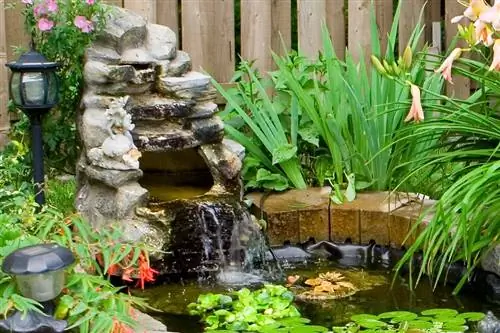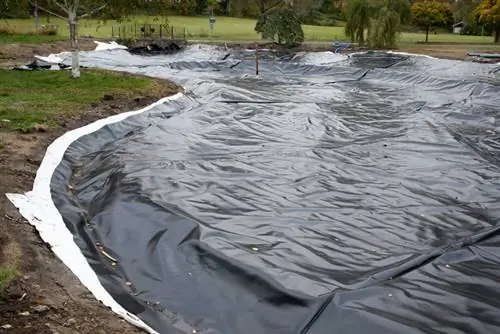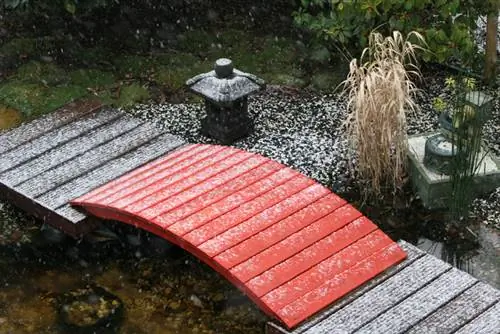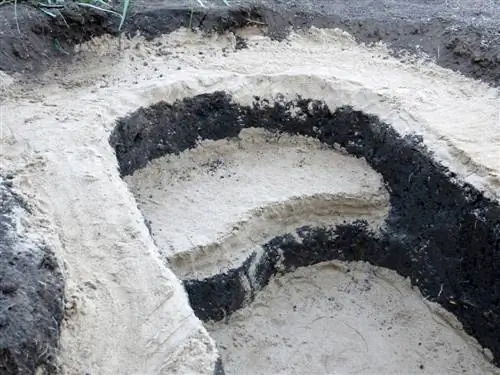- Author admin [email protected].
- Public 2023-12-16 16:46.
- Last modified 2025-06-01 06:02.
Every now and then you find yourself in the situation where you have to glue pond liners. You can read in detail how this works, what differences there are between individual pond liners and which adhesives and bonding methods are suitable for this in our article.
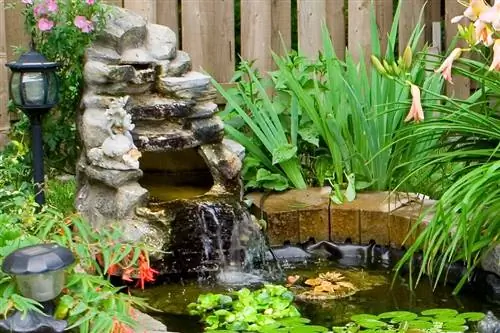
How do you stick pond liner correctly?
To glue pond liner, clean and dry the affected area, roughen it and use a suitable glue, such as special glue for PVC or rubber glue for EPDM films. After gluing and drying, you can fill the pond with water again.
Situations where gluing is required
Gluing pond liners is only necessary under certain, special circumstances:
- if the pond liner needs to be attached to other materials (e.g. a concrete wall) during installation
- if the individual parts of a stream that needs to be lined with pond liner need to be put together
- if a pond liner needs to be repaired
A film does not have to be glued for the installation itself. As a rule, the manufacturer provides the film ready-made in the required dimensions. The manufacturer welds the film together from individual strips - special industrial welding processes are used that cannot be used on the construction site.
In principle, self-welding is only possible with PVC films; you have to use solvent welding agents. The process is complex and error-prone and generally not recommended for use by laypeople. Gluing is always the safer alternative.
Types of pond liners
First you have to figure out whichtype of pond liner you actually want to glue. There is
- PVC pond liners
- Pond liners made of PE
- Pond liners made of EPDM, which is a special rubber material
- In rare cases, special (very expensive) geotextiles are used to replace the film
PVC films
PVC films are still the most widely used, despite their many disadvantages. However, they are the most cost-effective films and are also used in professional landscaping construction to line ponds.
Their shelf life is quite limited, they are poorly environmentally friendly and due to the chemical conversion processes that take place (the plasticizers escape after just a few years and the material becomes brittle) it is often difficult to glue older films cleanly and tightly.
EPDM films
EPDM films are the slightly more expensive, but very ecological and environmentally friendly variant. They have enormous durability and are also the easiest to repair in practice. Gluing does not cause any problems here.
PE films
PE films are rarely found, but are still used occasionally. They are somewhat more environmentally friendly than PVC films. As a rule, the same bonding processes and adhesives can be used for them as for PVC, but the adhesive strength is usually somewhat limited - you should always take this into account when bonding the films.
Geotextiles
Very different materials are sometimes used here, but they are extremely rare in pond construction and practically never found in private ponds. If such films need to be glued or repaired, professional repair is almost always required.
Gluing for repair
Films - no matter how durable and tear-resistant - are always damaged. Films can almost always be easily repaired by gluing, with the exception of PVC films, where gluing can often become problematic after just a few years. In these cases, however, the film is usually already so brittle and leaky that it should be completely replaced or renewed anyway.
Gluing PVC films
Special adhesives are used for PVC films to create a tight connection. These adhesives can usually also be used for PE films. Many of them liquefy the material during the exposure time and thus create a stable connection in the edge areas when the material that has flowed into one another has solidified again.
There are a few things to consider before gluing - the correct procedure can be found in our short instructions:
Glue PVC film correctly - step by step
- PVC film
- suitable glue
- Sandbags (or sandbags, depending on the size of the glued area)
1. Preparation
Place the film with the planned adhesive point on a completely flat surface (e.g. a board). The film must be completely clean and completely dry before sticking.
2. Treatment of the adhesive spot
The film must be roughened and pre-treated with an adhesive primer. The glue is then applied. It must act for a certain time according to the manufacturer's instructions.
3. Gluing
The seams are then placed together and pressed together tightly. Afterwards you have to stay weighed down with sandbags for a while so that the glued area holds well.
4. Aftercare
For greater tightness, the seams must then be sealed.
Glue EPDM film
Gluing EPDM films is much easier. For simple and hassle-free repairs, you can easily useliquid pond liner. The liquid pond liner is simply painted over the damaged area in 2 - 3 layers.
For a repair with glue (€15.00 on Amazon), use a special rubber glue. When gluing, always follow the manufacturer's instructions carefully. It is best to additionally secure an adhesive point on EPDM films with a special EPDM adhesive tape.
Tip
After a repair, you should always wait at least 1 - 2 days before the repaired area comes into contact with water again. So only refill your pond after this rest period. It can take a lot of effort to even find damage - you can read about the best way to do this in this article.

